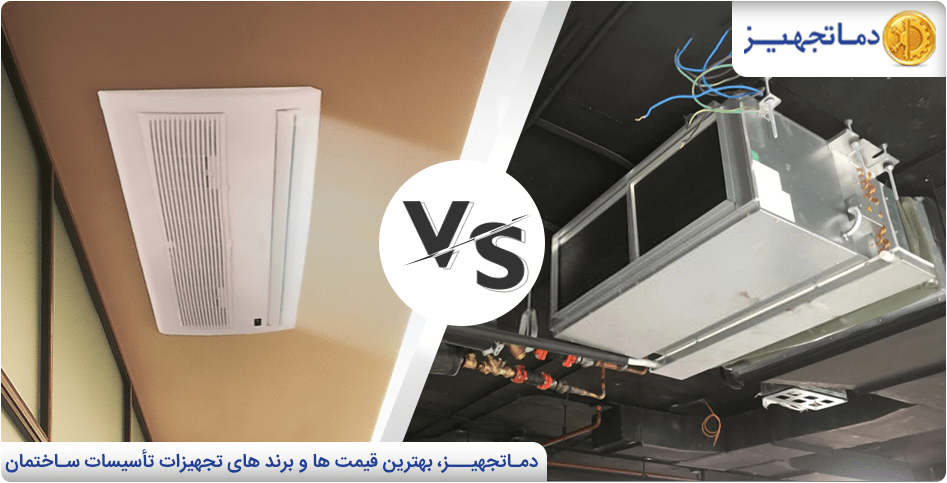Ceiling and channel fan coils, despite their various differences in terms of dimensions and installation methods, have a series of common components and generally follow the same goal. In this article, we examine the difference between ceiling and channel fan coils.

Types of ceiling fan coils
One of the types of fan coils is the ceiling fan coil that occupies the least amount of space during installation and can be installed on different surfaces. It also creates the least amount of noise compared to other fan coils, which is why it has many fans among users.
Ceiling fan coils are produced and supplied in two models, which include surface and built-in ceiling fan coils. In built-in fan coils, only the valve part is visible, but the cabinet or the body of surface-mounted fan coils can be seen completely in the interior view.
Ceiling fan coil
Surface-mounted fan coils are divided into two types, low pressure and high pressure, and in the high pressure type, the wind has more power. But the way it works and its structure is similar to the built-in type and they differ only in the need for channeling. Also, due to the face of these fan coils, it is much easier to access the internal components and parts for servicing and repairing the device compared to the built-in ceiling fan coil. One of the disadvantages of this device is that it takes up a lot of space.
Built-in ceiling fan coil
These models of fan coils are designed in two styles, with and without a cabin, and usually have a capacity between 200 and 1000 cubic feet per minute (cfm). The built-in ceiling fan coil has a simple appearance and is installed inside the false ceiling. This model of devices is quiet and has a reasonable price, and therefore they are more popular than other models. The reasonable price of the built-in ceiling fan coil is one of the things that makes many people go for it, but maybe it seems a little difficult to install it inside the ceiling.
Advantages and disadvantages of built-in ceiling fan coils
In the rest of this article, we will examine the advantages and disadvantages of built-in ceiling fan coils. Advantages of built-in ceiling fan coil:
- Quiet and quiet operation
- Equipped with thermostat and remote control
- Access to fresh air outside and its entry into the building if using a fresh air channel
- with different capacities
- Less volume and occupying less space due to installation on the roof of the building
- More reasonable price than ground fan coils
- Optimum performance in providing hot and cold air due to the use of their copper coil pipes
- Simplicity in design due to placement inside the ceiling
Disadvantages of built-in ceiling fan coil:
- Difficult access to its parts due to the placement of the device in the false ceiling (if any part of it is damaged or needs to be replaced, it will cause a heavy cost for the user.)
- Difficulty in cleaning the filter, which reduces the life of the device.
Ducted fan coils
Channel fan coil is another model of fan coils, which of course is also known as duct fan coil. These fan coils are like ceiling models and are usually installed inside the ceiling, but the difference between built-in and ducted ceiling fan coils is that there is a need for ducting in the ducted model. These devices use chillers to provide cold water, but if they are used for heating, they use wall or ground packages or central engine houses to provide hot water.
Ducted fan coils have larger capacities than recessed ceiling fan coils, ranging from 600 to 2,000 cubic feet per minute (cfm), and can be manufactured for both high and low static pressures.
Advantages and disadvantages of channel fan coils
In the rest of the article, we will describe the advantages and disadvantages of channel fan coils.
- Equipped with a tray for collecting distilled water
- It has an aeration capacity of up to 2000 cfm
- Use of washable aluminum filters in the air inlets
- suitable for use in hospitals, hotels and offices (due to higher capacity compared to ceiling fan coils)
Damatajhiz; The best prices and brands of building installation equipment
Among the disadvantages of the ducted fan coil, we can mention the need for ducting and its difficult installation. One or two hot and cold water pipes are enough to install the other models of this device. But the installation of a ducted fan coil requires ducting, which is done according to engineering drawings and by experts. Also, it is difficult to service and repair the device in case of failure.
Another disadvantage of channel fan coils that is considered is its sound, which actually produces the highest amount of sound compared to all types of fan coils. Therefore, it should be used and installed in corridors or lobbies of commercial buildings.
The main difference between ceiling and channel fan coils
The following are the most important differences between ceiling and channel fan coils:
- The capacity of channel fan coils is more than that of ceiling fan coils.
- Ceiling fan coils can be installed on all surfaces, while there are restrictions for installing channel fan coils on different surfaces.
- Ceiling fan coils are the least noisy, while ducted fan coils are more noisy
final word
In this article, we have provided explanations about the difference between ceiling fan coil and channel fan coil, in which we have given a full explanation of each, the advantages of ceiling fan coils and channel fan coils, so that you can choose one of them according to the needs and application of your project. Choose and use it. During office hours, you can contact the experts of Damatajhiz specialized collection to receive advice on choosing and buying cooling and ventilation equipment.
Related Articles
THE DIFFERENCE BETWEEN UNIT HEATER AND FAN COIL
INTRODUCING TYPES AND THE BEST TYPE OF FAN COIL
Looking forward to calling and to meet you in the Specialized Collection of Damatajhiz
By sharing the above article on social networks, let your friends know about its important content.


